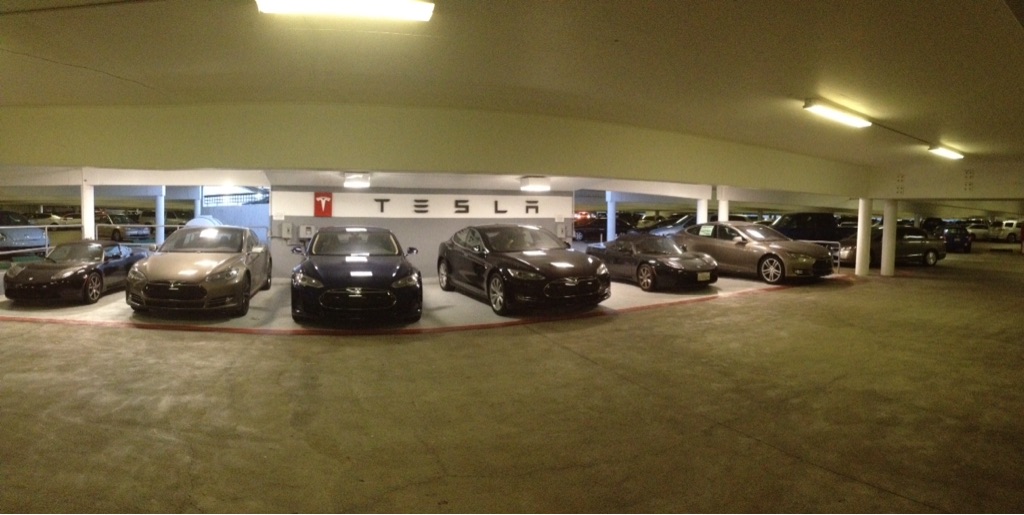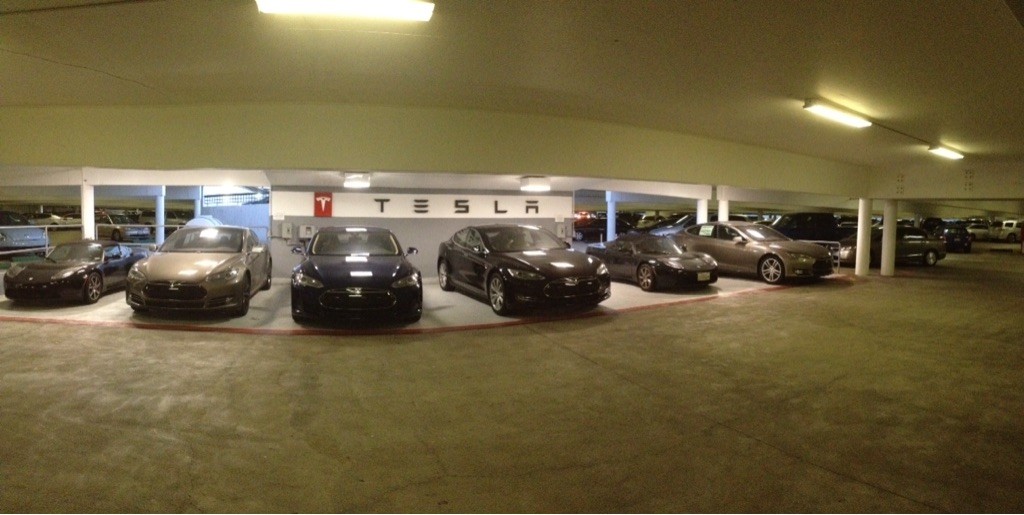Investor's Corner
Tesla Grabbing Sales From German Car Makers
A report from Germany says Tesla is taking sales away from German car makers in the luxury car segment of the market. It say plug-in hybrids are a dead end.


[Source: @dennis_p via Teslarati App check-in]
Professor Ferdinand Dudenhoeffer is the director of the Center for Automotive Research in Germany. He has written a report entitled “Tesla Asserts Itself In The Luxury Class,” in which he says the big three German car makers have wasted money on plug-in hybrids — which he calls a blind alley. They are also losing sales in the most profitable end of the luxury market to Tesla, he says.
“In a lot of markets we are seeing Tesla doing better than the BMW 7 series, Mercedes S class, Audi A8 and Porsche Panamera. Tesla can boast real innovation and customers with big money are trying it. I’m not sure if Tesla will be successful in the long term but when they broaden the line we will see if it can bring revolution to the car industry.”
Are plug-in hybrids really a blind alley as Professor Dudenhoeffer suggests? A report in Forbes says IHS Automotive recently looked again at its medium to long range forecasts and raised its prediction for electric vehicles in 2020 to just over 1% of the global market. It says that figure will only increase to 1.5% by 2025.
By contrast, IHS says global market share for hybrids and plug-in hybrids will be 7% in 2020. It expects that figure will rise to 16% by 2025 as upcoming US and European regulations require all cars to have better fuel economy and lower carbon dioxide emissions.
But Dudenheoffer doubts those forecasts are correct. He says plug-in hybrids are not proving popular with buyers and are seen as not environmentally friendly because they often use internal combustion engines to get where they are going. He points out that even in markets like Germany and Switzerland, where there are no subsidies for electric vehicles, the Tesla Model S is stealing sales from the Mercedes S class.
“I think plug-in hybrids are the wrong direction and will not be successful. The costs are too high. The weight of the car is too high,” Dudenhoeffer told Forbes. “I think environmentalists and governments will come to the conclusion that plug-in hybrids are not real progress.” His remarks are targeted specifically at Mercedes, which has 3 plug-in hybrid models on sale already and promises to add 7 more soon.
Tesla is doing an excellent job of disrupting the traditional German luxury car manufacturers. The real battle will come when it adds the Model 3 to the mix. It’s one thing to steer customers away from buying an S Class or 7 Series. It’s something else entirely to take sales away from mid-market models, where shoppers have many more choices and the price competition is fierce.
Tesla’s electric cars versus the other guys’ plug-in hybrids. Who will win that fight? The answer will not be entirely market driven, because government regulations will skew the results. That may give an advantage to plug-ins, at least temporarily. The car business will undergo transformative change in the next five years. Tesla has always shown an amazing ability to recognize and adapt to change and that may be its ultimate weapon in the upcoming battle.

Investor's Corner
Tesla stock closes at all-time high on heels of Robotaxi progress

Tesla stock (NASDAQ: TSLA) closed at an all-time high on Tuesday, jumping over 3 percent during the day and finishing at $489.88.
The price beats the previous record close, which was $479.86.
Shares have had a crazy year, dipping more than 40 percent from the start of the year. The stock then started to recover once again around late April, when its price started to climb back up from the low $200 level.
This week, Tesla started to climb toward its highest levels ever, as it was revealed on Sunday that the company was testing driverless Robotaxis in Austin. The spike in value pushed the company’s valuation to $1.63 trillion.
Tesla Robotaxi goes driverless as Musk confirms Safety Monitor removal testing
It is the seventh-most valuable company on the market currently, trailing Nvidia, Apple, Alphabet (Google), Microsoft, Amazon, and Meta.
Shares closed up $14.57 today, up over 3 percent.
The stock has gone through a lot this year, as previously mentioned. Shares tumbled in Q1 due to CEO Elon Musk’s involvement with the Department of Government Efficiency (DOGE), which pulled his attention away from his companies and left a major overhang on their valuations.
However, things started to rebound halfway through the year, and as the government started to phase out the $7,500 tax credit, demand spiked as consumers tried to take advantage of it.
Q3 deliveries were the highest in company history, and Tesla responded to the loss of the tax credit with the launch of the Model 3 and Model Y Standard.
Additionally, analysts have announced high expectations this week for the company on Wall Street as Robotaxi continues to be the focus. With autonomy within Tesla’s sights, things are moving in the direction of Robotaxi being a major catalyst for growth on the Street in the coming year.
Elon Musk
Tesla needs to come through on this one Robotaxi metric, analyst says
“We think the key focus from here will be how fast Tesla can scale driverless operations (including if Tesla’s approach to software/hardware allows it to scale significantly faster than competitors, as the company has argued), and on profitability.”

Tesla needs to come through on this one Robotaxi metric, Mark Delaney of Goldman Sachs says.
Tesla is in the process of rolling out its Robotaxi platform to areas outside of Austin and the California Bay Area. It has plans to launch in five additional cities, including Houston, Dallas, Miami, Las Vegas, and Phoenix.
However, the company’s expansion is not what the focus needs to be, according to Delaney. It’s the speed of deployment.
The analyst said:
“We think the key focus from here will be how fast Tesla can scale driverless operations (including if Tesla’s approach to software/hardware allows it to scale significantly faster than competitors, as the company has argued), and on profitability.”
Profitability will come as the Robotaxi fleet expands. Making that money will be dependent on when Tesla can initiate rides in more areas, giving more customers access to the program.
There are some additional things that the company needs to make happen ahead of the major Robotaxi expansion, one of those things is launching driverless rides in Austin, the first city in which it launched the program.
This week, Tesla started testing driverless Robotaxi rides in Austin, as two different Model Y units were spotted with no occupants, a huge step in the company’s plans for the ride-sharing platform.
Tesla Robotaxi goes driverless as Musk confirms Safety Monitor removal testing
CEO Elon Musk has been hoping to remove Safety Monitors from Robotaxis in Austin for several months, first mentioning the plan to have them out by the end of 2025 in September. He confirmed on Sunday that Tesla had officially removed vehicle occupants and started testing truly unsupervised rides.
Although Safety Monitors in Austin have been sitting in the passenger’s seat, they have still had the ability to override things in case of an emergency. After all, the ultimate goal was safety and avoiding any accidents or injuries.
Goldman Sachs reiterated its ‘Neutral’ rating and its $400 price target. Delaney said, “Tesla is making progress with its autonomous technology,” and recent developments make it evident that this is true.
Investor's Corner
Tesla gets bold Robotaxi prediction from Wall Street firm
Last week, Andrew Percoco took over Tesla analysis for Morgan Stanley from Adam Jonas, who covered the stock for years. Percoco seems to be less optimistic and bullish on Tesla shares, while still being fair and balanced in his analysis.

Tesla (NASDAQ: TSLA) received a bold Robotaxi prediction from Morgan Stanley, which anticipates a dramatic increase in the size of the company’s autonomous ride-hailing suite in the coming years.
Last week, Andrew Percoco took over Tesla analysis for Morgan Stanley from Adam Jonas, who covered the stock for years. Percoco seems to be less optimistic and bullish on Tesla shares, while still being fair and balanced in his analysis.
Percoco dug into the Robotaxi fleet and its expansion in the coming years in his latest note, released on Tuesday. The firm expects Tesla to increase the Robotaxi fleet size to 1,000 vehicles in 2026. However, that’s small-scale compared to what they expect from Tesla in a decade.
Tesla expands Robotaxi app access once again, this time on a global scale
By 2035, Morgan Stanley believes there will be one million Robotaxis on the road across multiple cities, a major jump and a considerable fleet size. We assume this means the fleet of vehicles Tesla will operate internally, and not including passenger-owned vehicles that could be added through software updates.
He also listed three specific catalysts that investors should pay attention to, as these will represent the company being on track to achieve its Robotaxi dreams:
- Opening Robotaxi to the public without a Safety Monitor. Timing is unclear, but it appears that Tesla is getting closer by the day.
- Improvement in safety metrics without the Safety Monitor. Tesla’s ability to improve its safety metrics as it scales miles driven without the Safety Monitor is imperative as it looks to scale in new states and cities in 2026.
- Cybercab start of production, targeted for April 2026. Tesla’s Cybercab is a purpose-built vehicle (no steering wheel or pedals, only two seats) that is expected to be produced through its state-of-the-art unboxed manufacturing process, offering further cost reductions and thus accelerating adoption over time.
Robotaxi stands to be one of Tesla’s most significant revenue contributors, especially as the company plans to continue expanding its ride-hailing service across the world in the coming years.
Its current deployment strategy is controlled and conservative to avoid any drastic and potentially program-ruining incidents.
So far, the program, which is active in Austin and the California Bay Area, has been widely successful.








